Related Research Articles
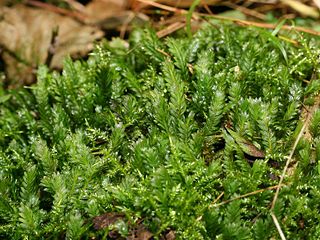
Fissidens adianthoides, the maidenhair pocketmoss, is a moss in the family Fissidentaceae. It was first collected by Hedwig in 1801.

Sabiaceae is a family of flowering plants that were placed in the order Proteales according to the APG IV system. It comprises three genera, Meliosma, Ophiocaryon and Sabia, with 66 known species, native to tropical to warm temperate regions of southern Asia and the Americas. The family has also been called Meliosmaceae Endl., 1841, nom. rej.

Eupomatia is a genus of three flowering shrub species of the Australian continent, constituting the only genus in the ancient family Eupomatiaceae. The Eupomatiaceae have been recognised by most taxonomists and classified in the plant order Magnoliales. The three species of shrubs or small trees grow naturally in the rainforests and humid eucalypt forests of eastern Australia and New Guinea. The type species Eupomatia laurina was described in 1814 by Robert Brown.
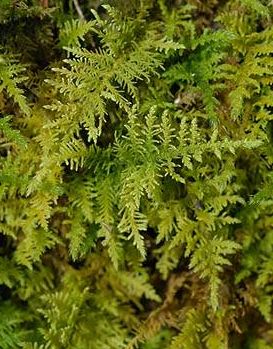
Hypnales is the botanical name of an order of Bryophyta or leafy mosses. This group is sometimes called feather mosses, referring to their freely branched stems. The order includes more than 40 families and more than 4,000 species, making them the largest order of mosses.

Symphyotrichum lateriflorum is a species of flowering plant in the aster family (Asteraceae). Commonly known as calico aster, starved aster, and white woodland aster, it is native to eastern and central North America. It is a perennial and herbaceous plant that may reach heights up to 120 centimeters and widths up to 30 centimeters.
Liatris cymosa, also known as Aggie-land gayfeather or branched blazing star, is a plant species in the family Asteraceae and genus Liatris. It is native to east central Texas in North America, where it is found in habitats such as post oak woodlands, fields, fence rows, woodland openings and edges, in clay soils. It blooms in mid to late summer with purple flower heads. It is of conservation concern due to habitat loss.

Warnstorfia exannulata is a leafy branching wetland moss in the genus Warnstorfia within the family Amblystegiaceae and class Bryopsida. This bryopsida moss is also known as ringless-hook moss or Warnstorfia moss. It is the most common species of the genus in wetland environments and can be difficult to distinguish from others within the genus. It grows in acidic soils like fens and bogs, or in freshwater pools and lakes.
Arthrocnemum was a genus of shrubs in the family Amaranthaceae. Two or three species were included in the genus. They are halophytes with fleshy, apparently articulated plant stems and reduced leaves and flowers.

Climacium dendroides, also known as tree climacium moss, belongs in the order Hypnales and family Climaciaceae, in class Bryopsida and subclass Bryidae. It is identified as a "tree moss" due to its distinctive morphological features, and has four species identified across the Northern Hemisphere. The species name "dendroides" describes the tree-like morphology of the plant, and its genus name came from the structure of the perforations of peristome teeth. This plant was identified by Weber and Mohr in 1804. They often have stems that are around 2-10 cm tall and growing in the form of patches, looking like small palm-trees. They have yellow-green branches at the tip of stems. The leaves are around 2.5-3 mm long, with rounder stem leaves and pointier branch leaves. Their sporophytes are only abundant in late winter and early spring, and appears as a red-brown shoot with long stalk and cylindrical capsules.
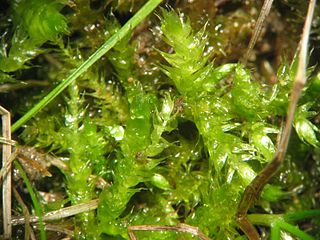
Brachytheciaceae is a family of mosses from the order Hypnales. The family includes over 40 genera and 250 species.
Meterotiaceae is a family of mosses from the order Hypnales. There are about 30 genera and 260 species represented by the family.

Fissidens limbatus commonly known as Herzog's pocket-moss, is a moss in the family Fissidentaceae. This species is found growing in high elevations in tropical America in addition to the US, Mexico and Canada. Montagne first collected F. crispus in 1838.

Sphagnum papillosum, the papillose peatmoss, is a species of peat moss distributed throughout the northern hemisphere. Although sometimes confused with Sphagnum imbricatum and Sphagnum palustre, it is distinguished by its yellow-green to brown short, blunt branches and papillose chlorophyllose cells.

Syntrichia latifolia, formerly Tortula latifolia, and commonly known as water screw-moss, is a species of moss belonging to the family Pottiaceae. Syntrichia species differ from members of Tortula due to synapomorphic leaf qualities, such as different basal and distal cells, as well as different costal cross sections where Tortula has an abaxial epidermis and Syntrichia lacks one.
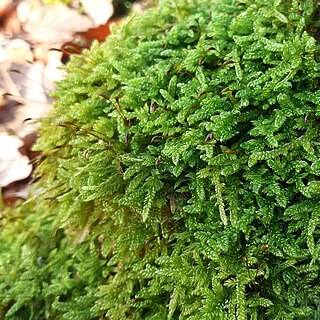
Hypnum is a genus of mosses belonging to the family Hypnaceae.

Micranthes occidentalis, commonly known as western saxifrage, is a species of flowering plant native to North America.
Claopodium crispifolium, crispleaf roughmoss, is a moss species in the family Leskeaceae. It is an epiphyte growing on trees in North America.

Fabroniaceae is a family of mosses belonging to the order Hypnales. It has a worldwide distribution, in temperate and tropical regions.
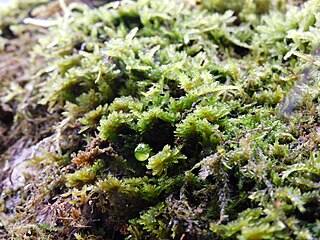
Leptodontaceae is a family of mosses belonging to the order Hypnales. There are 3 genera with a worldwide distribution.

Wijkia extenuata, commonly known as spear moss or spiky wiki, is a species of moss from the family Pylaisiadelphaceae. It can be divided into two varieties Wijkia extenuata '-var. caudata and Wijkia extenuata var. extenuata. It is commonly found throughout the tropical, subtropical, and temperate forests of eastern Australasia and New Zealand.
References
- ↑ Smith, Anthony John Edwin (1980-09-04). The Moss Flora of Britain and Ireland. Cambridge University Press. pp. 493–. ISBN 9780521299732 . Retrieved 6 December 2017.
- ↑ Noguchi, Akira (1937). Studies on the Japanese Mosses of the Orders Isobryales and Hookeriales: II. Hirosima University. Retrieved 6 December 2017.
- ↑ "ITIS Standard Report Page: Isobryales". www.itis.gov. Retrieved 2018-12-24.
- ↑ "Hypnales". NCBI. Retrieved 4 May 2020.
- 1 2 "Isobryales". www.gbif.org. Retrieved 28 July 2022.
- ↑ Crum, Howard (2020). "Isobryales". Access Science. doi:10.1036/1097-8542.354800 . Retrieved 28 July 2022.